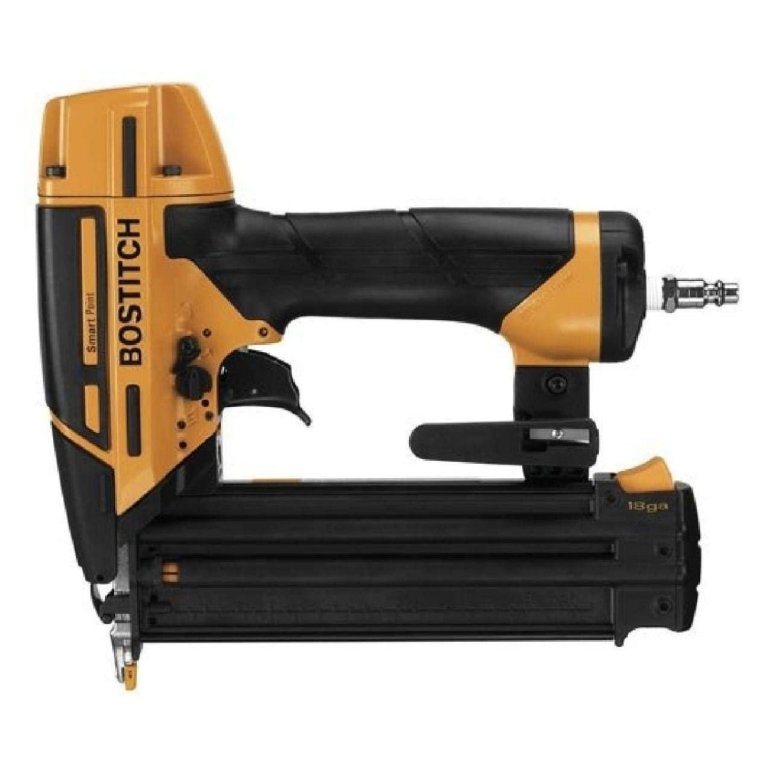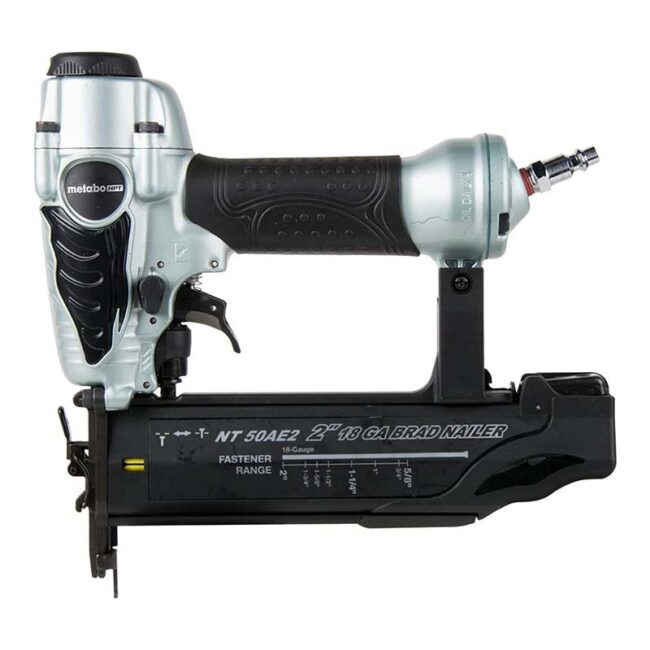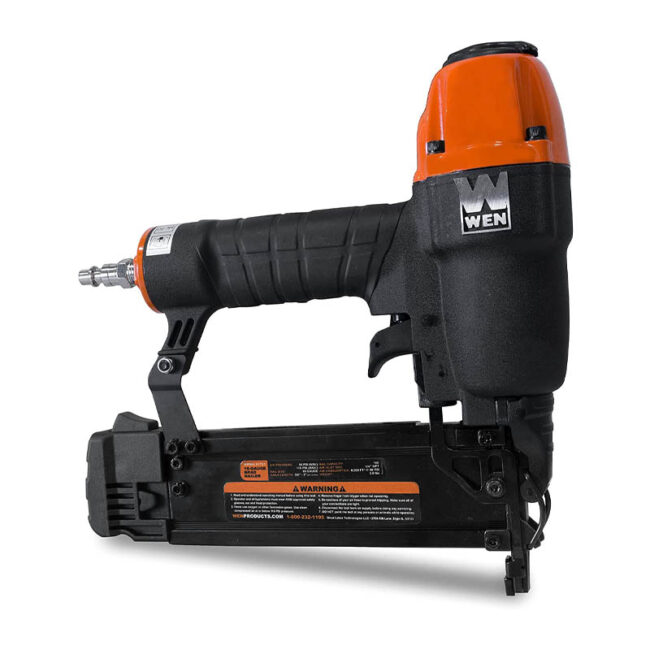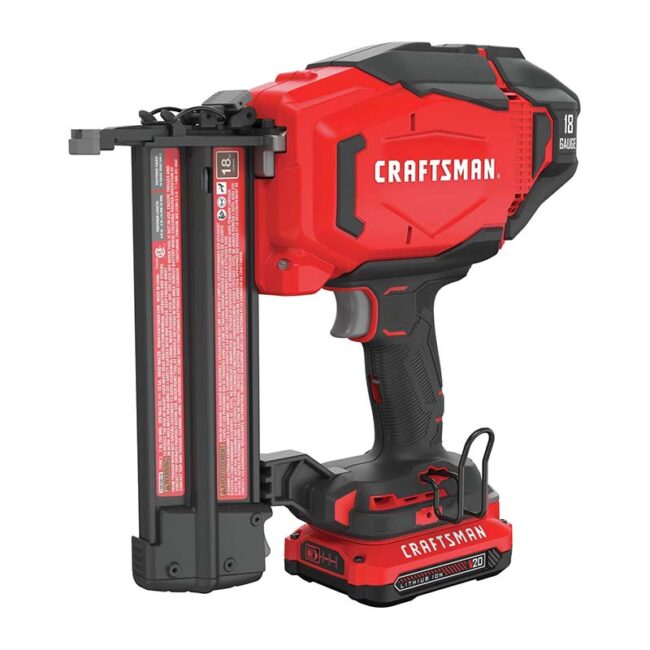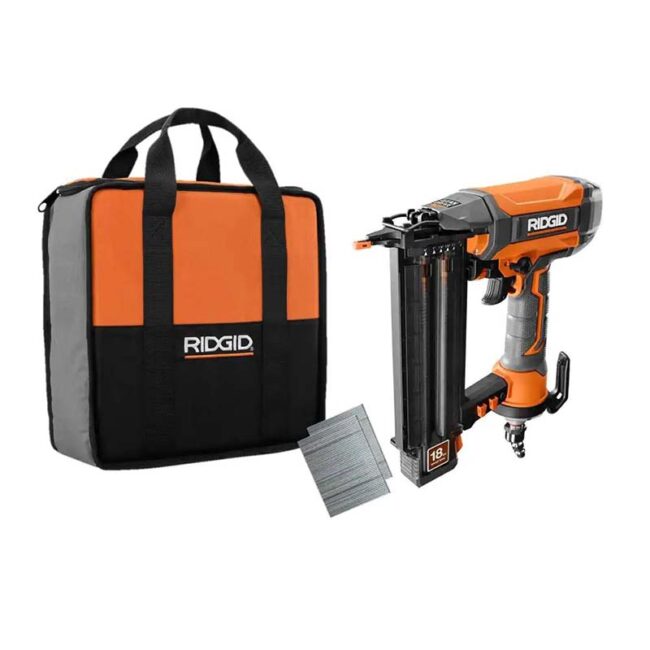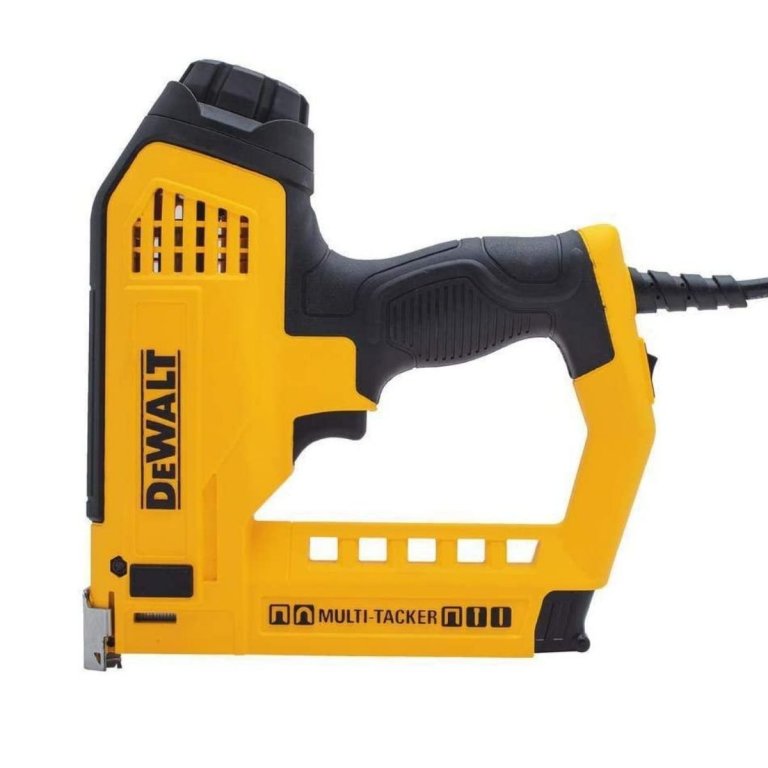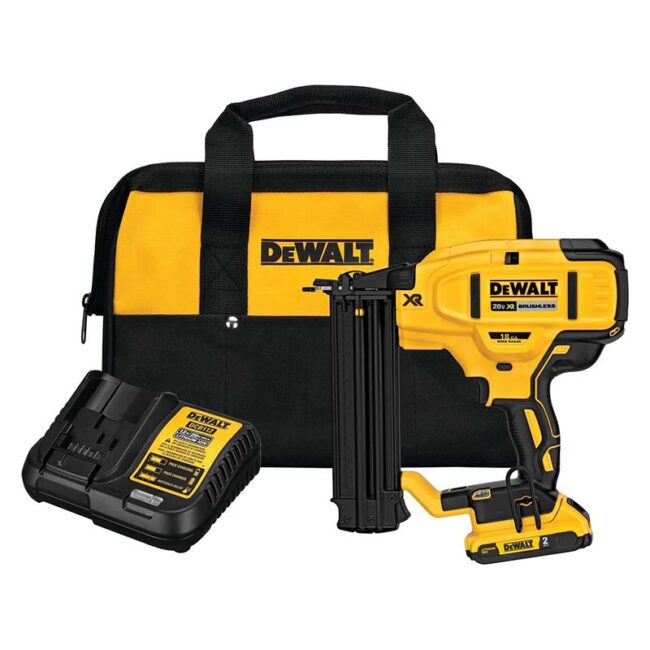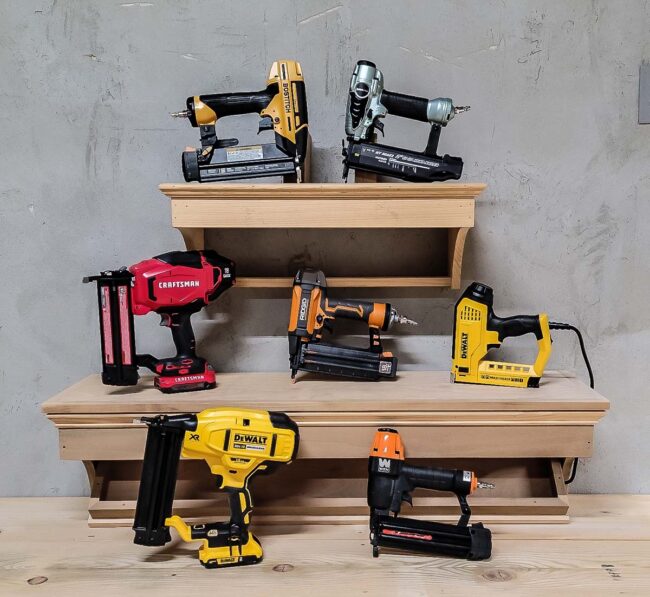
We may earn revenue from the products available on this page and participate in affiliate programs. Learn More ›
Brad nailers helped spur the DIY movement by making quality trim projects achievable for DIYers and pros alike. These efficient tools fire 18-gauge nails, which are less likely to split fine wood moldings since they’re thinner than the 16-gauge versions used by a finish nailer.
Like many woodworkers, we’re big fans of high-quality brad nailers for installing molding and completing woodworking projects, so we put several models through extensive hands-on testing to find the top options. We fired thousands of nails, using each tool in the same ways finish carpenters and cabinetmakers use them, and we took careful note of each model’s strengths and weaknesses. We also reached out to a few other tool experts to get their insight on specific features shoppers should look out for.
Choosing the right brad nailer could mean the difference between a professional-looking job and an amateurish mess. Ahead, learn what to look for when shopping for the best brad nailer, and find out how the following models earned their spot on our lineup.
- BEST OVERALL: Bostitch BTFP12233 Smart Point Brad Nailer Kit
- RUNNER-UP: Metabo HPT NT50AE2M 18-Gauge 2-Inch Brad Nailer
- BEST BANG FOR THE BUCK: Wen 61721 18-Gauge Pneumatic Brad Nailer
- UPGRADE PICK: Craftsman CMCN618C1 V20 Cordless Brad Nailer Kit
- BEST PNEUMATIC: Ridgid R213BNF 18-Gauge 2⅛-Inch Brad Nailer
- BEST CORDED: DeWalt DWHT75021 Electric 5-in-1 Multi-Tacker
- BEST CORDLESS: DeWalt DCN680D1 20V MAX Cordless Brad Nailer Kit
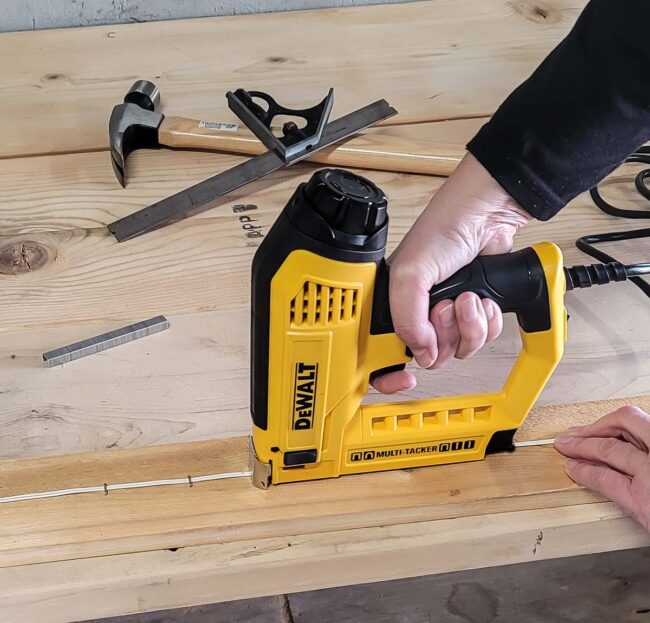
How We Tested the Best Brad Nailers
Brad nailers are professional-grade precision power tools and DIY favorites, so we took a multipronged approach when deciding which models to test.
Before getting our hands on them, though, we interviewed Ben Illig, a general contractor with decades of experience and owner of Illig Properties in Pennsylvania. He says that “it is very important for a Brad nailer to be small and compact so that it can fit in spaces where other nail guns may not.” He also stressed that “it’s important to have a good No Mar rubber tip so that the nail gun leaves as little blemish as possible on the wood or other surface.” We made sure to take these expert tips into consideration when selecting our lineup for testing.
We first chose top-rated options from brands we know and trust. Bostitch and DeWalt have great reputations for making quality brad nailers, so we included their top picks. We also chose models that rate high with home woodworkers and are more budget-friendly. We selected corded, cordless, and pneumatic brad nailers within these categories.
We then performed extensive testing in our woodshop—using the brad nailers on hardwoods, including oak and ash, and softer pine boards, since painted pine is a common choice for trim. We noted how easy it was to adjust the brad’s depth and looked for user-friendly features, such as tool-free jam releases. We tested the longest and shortest brads the tools would accommodate and tried all their features, such as single-shot and multishot modes.
We looked for top performance from the brad nailers we tested—no one wants to stop and clear repeated jams or use a nail set to countersink brads that don’t do so upon firing.
We made notes of all pros and cons of each tool and awarded points based on a rubric. The better a brad nailer performed a test, the higher the points it received. After testing, we tallied the scores and determined the best categories for each tool.
Our Top Picks
This list of picks for the best brad nailers represents the top-performing models in our woodshop tests. They represent a range of uses—including models that withstand heavy-duty use, light-duty brad nailers that also offer staple benefits, and budget-friendly picks that excel in shooting brads without splitting wood.
All models fire 18-gauge brads, which is a requirement for brad nailers. Each earned its spot on this lineup, and one is sure to be a top pick for your DIY projects.
Best Overall
Bostitch BTFP12233 Smart Point Brad Nailer Kit
See ItWhat We Like
- The Bostitch Smart Point brad nailer’s compact nose fits into tight spots
- Offers tool-free jam release for removing brads that jam in the tool
- Features single- and bump-firing modes that accommodate precision placement or quick-fire shooting
What We Don’t Like
- Depth-adjustment dial is on the small side and is slightly difficult to see and turn
- Pneumatic connection nipple does not swivel, so the air compressor hose sticks out
Product Specs
- Type: Pneumatic
- Tool-free clearing: Yes
- Modes: Single and bump
This Bob Vila Approved product carries our brand’s highest level of recommendation.

Bob Vila Approved recognizes the household and DIY products that impressed us most in our real-world testing and that exemplify core values of the Bob Vila brand, including craftsmanship, innovation, and value for the dollar. Winners of this designation come recommended by our professional review team and are personally approved by Bob Vila.
Anyone looking for an overall top-quality brad nailer may want to check out the Bostitch Smart Point. This brad nailer fires nails between ⅝ inch and 2⅛ inches long, and it performed well with the longest and shortest nail lengths as well as those in between. Fortunately, we didn’t have any brad jams (the shooting mechanism is well tuned), but the Bostitch comes with a tool-free jam release in the event a jam occurs.
We fired more than 200 brads through the Bostitch, using single-shot and multishot (or “bump”) modes. We toggled between modes by turning a small switch near the trigger. In bump mode, the Bostitch shot a brad every time we pressed the nose of the nailer against the wood. We’re not big fans of bump modes on brad nailers; with trim nailers, it’s best to align each brad precisely before firing. But for those who want bump-firing mode, the Bostitch performs quite well.
We connected the Bostitch to our air compressor via a hose (not included), and we noted a slight downside: The nipple on the back of the nailer does not swivel. This is a minor inconvenience, but without a swivel nipple, the air compressor hose stuck straight up when we used the belt hook to carry the tool on our tool belt. The other downside is the size of the depth-adjustment dial. It’s located on the inner frame below the trigger, which is handy, but at about the size of a dime, it’s relatively small, so adjusting it is inconvenient.
On the plus side, this brad nailer comes with a carrying case, three no-mar tips that keep the nailer from indenting softwood, and a built-in pencil sharpener on the back of the belt hook. In terms of performance, the Bostitch fired brads of all lengths into oak, ash, and pine boards without splitting any.
Read our full review: Bostitch BTFP12233 Smart Point Brad Nailer Kit
Get the Bostitch brad nailer at Amazon, Lowe’s, Ace Hardware, Acme Tools, or Walmart.
Runner-Up
Metabo HPT NT50AE2M 18-Gauge 2-Inch Brad Nailer
See ItWhat We Like
- Adjustable exhaust port on the top of the tool allows users to redirect the poof of air that comes out with every shot
- Reload indicator that alerts when low on brads so user can add more to keep from running out
- Angled hose nipple helps keep the hose up and out of the user’s way
What We Don’t Like
- This brad nailer didn’t come with a belt hook or extra no-mar nose tips
Product Specs
- Type: Pneumatic
- Tool-free clearing: Yes
- Modes: Single and bump
The pneumatic brad nailer from Metabo HPT is worth a look for those wanting a high-quality nailer powered by air compression. This 18-gauge nailer can fire brads between ⅝ inch and 2 inches, which is an ample range for most remodeling and trim projects.
This Metabo brad nailer is a no-nonsense model that doesn’t come with many bells and whistles, but it drives brads quickly and cleanly with single-shot mode or bump mode. Both modes worked well, and we had just two brads jam when using the bump mode. Those jams were simple to remove using the tool-free jam release on the Metabo’s nose.
The depth dial was easy to adjust using a thumb or finger, and the nailer had a handy reload indicator in the sliding magazine that showed when we ran low on nails.
This pneumatic nailer has a lot of power and shoots brads easily into hardwoods and pine without splitting the wood. We found it ergonomic and comfortable, which goes a long way when working on a sizable trim project. It doesn’t have a swivel air nipple, but the nipple is angled upward, which helps keep the hose out of the way.
One of our favorite features on this model was the adjustable exhaust port on the top of the nailer. Turning it redirected the poof of compressed air released by the pneumatic tool, which meant we could prevent air from blowing in our faces or blowing sawdust across the room, no matter how we held the tool. The nailer came with a hard case and a pair of safety glasses, but it didn’t come with a belt hook, which would have been handy.
Get the Metabo brad nailer at Amazon, Lowe’s, Ace Hardware, Target, Walmart, or Acme Tools.
Best Bang for the Buck
Wen 61721 18-Gauge Pneumatic Brad Nailer
See ItWhat We Like
- Value-minded price point is a boon for those looking to install trim projects without spending a lot
- Tool-free adjustments and jam clearing keep the project’s process moving along
- Exhaust port turns in any direction to direct the poof of air away from faces or dusty surfaces
What We Don’t Like
- Doesn’t feature bump-firing mode, but that’s only a minor downside
Product Specs
- Type: Pneumatic
- Tool-free clearing: Yes
- Modes: Single mode only
When it comes to low-price tools that pack a lot of value, Wen leads the way. This precision brad nailer fires ⅜-inch to 2-inch-long brads, making it more versatile than some higher-priced nailers. It features a spring-loaded magazine, an adjustable depth drive, and a tool-free jam release.
In our tests, the Wen shot long and short brads equally well into both hard and soft wood, and adjusting the brad depth was simple with the easily accessible dial near the trigger. The tool’s exhaust port is adjustable, which allowed us to direct it away from our faces and dusty surfaces when firing brads. The air-hose nipple doesn’t swivel, but we didn’t expect it to at this price point.
This brad nailer doesn’t feature an automatic bump setting or come with a belt hook, but it gets the job done, and we had only one jam while firing more than 200 brads. That jam was easy to remove via the tool-free jam release located on the nose of the nailer. This affordable model is well suited to DIYers who are just starting to build their power tool collections, and it’s a bargain for a good-quality nailer.
Get the Wen brad nailer at Amazon, Lowe’s, The Home Depot, or Walmart.
Upgrade Pick
Craftsman CMCN618C1 V20 Cordless Brad Nailer Kit
See ItWhat We Like
- Ability to use the tool in remote areas without access to electricity; perfect for DIYers as well as professionals
- Features a tool-free stall release in addition to a tool-free jam release for excellent user-friendliness
- Comes with a rechargeable lithium-ion battery and battery charger
What We Don’t Like
- Runs a couple of pounds heavier than most pneumatic brad nailers
Product Specs
- Type: Cordless electric
- Tool-free clearing? Yes
- Modes: Single mode only
Cordless power tools of all types are trending, and for good reason—they offer users the ability to take the devices anywhere, even to woodworking projects in remote areas without access to electricity.
We’re huge fans of cordless tools now that lithium-ion batteries seem to grow more powerful by the year, and Craftsman’s cordless brad nailer is no exception. It handles a range of brad lengths, from ⅝ inch to 2 inches long, and we like the idea of not having a cord or an air hose to drag around or trip over.
The Craftsman V20 comes with a 2 amp-hour (Ah) rechargeable battery and a charger. We plugged in the battery overnight to ensure it was fully charged before testing. After firing more than 200 brads through the tool, we still had plenty of power left.
This electric brad nailer is as powerful as a pneumatic nailer, and it fires both long and short brads with ease into hardwood and pine. The depth adjustment is a handy dial on the nose of the tool. It also has an LED guide light that illuminates the workpiece in dim lighting. It doesn’t come with a bump mode, but it does come with a tool-free jam release and a stall release.
Stall releases are almost exclusively found on cordless nailers, and they’re slightly different from jam releases. If the tool doesn’t set a nail deep enough, the top of the nail can become lodged in the nose while the tip of the nail is in the wood. The user could open the jam release and pull the nail out using a pair of pliers, but a stall release lever dislodges the brad from the tool without the user having to open the jam release. Stalls are prone to happen when the battery runs low and doesn’t have the power to set the nail completely. We didn’t experience any stalls during testing, but we did have one jam that we removed quickly via the tool-free jam release.
The downside for some will be the added weight of the Craftsman brad nailer; its battery increases the weight by about 2 to 3 pounds over that of most pneumatic brad nailers. Still, the ability to work without dragging a hose or a cord around outweighs the added couple of pounds.
Get the Craftsman brad nailer at Amazon, Lowe’s, Ace Hardware, or Craftsman.
Best Pneumatic
Ridgid R213BNF 18-Gauge 2⅛-Inch Brad Nailer
See ItWhat We Like
- Brad nailer uses Clean Drive Technology to shoot nails, which reduces the risk of jams
- Depth-adjustment dial is large and easy to use, and its contrasting color makes it stand out
- Swivel air-hose nipple allows air hose to drop out of the way when users carry the tool on a belt
What We Don’t Like
- Handle storage for the 2 extra no-mar tips is unreliable
Product Specs
- Type: Pneumatic
- Tool-free clearing? Yes
- Modes: Single and bump
Ridgid, one of The Home Depot’s flagship brands, has done it again. The pneumatic Ridgid brad nailer performs just as well as other top-name pneumatic models we tested, and it offers some enviable extras that make working on trim projects a snap.
The Ridgid was the only pneumatic brad nailer we tested that came with a swivel nipple. The swivel function makes it much more convenient to carry on a tool belt because it allows the hose to drop off to the side rather than stick straight up in the way of our hands. Plus, the belt hook rotates from one side to the other, making it accessible to both right- and left-handed users.
While all the other models we tested came with low-nail indicators on the magazine, Ridgid’s magazine is transparent, so we could see exactly how many nails were left.
The Ridgid held its own in terms of performance. It accepts brads from ⅝ inch to 2⅛ inches, and we fired over 200 shots in both single-fire and bump modes without any jams. That meant we didn’t get a chance to use the tool-free jam release, but that’s a good thing. We tested the nailer on both hardwood and pine.
The Ridgid brad nailer is ergonomically designed and comfortable to use. It shoots both long and short brads equally well, and the depth-adjustment dial is large and easy to access. This is a high-performing brad nailer, with only one slight downside: The two included no-mar tips stored on the handle kept falling off. Users will likely want to house these extras in a separate location.
Get the Ridgid brad nailer at The Home Depot.
Best Corded
DeWalt DWHT75021 Electric 5-in-1 Multi-Tacker
See ItWhat We Like
- The DeWalt tacker fires brads and staples, making it suitable for a range of uses
- Can shoot brad nails as well as narrow crown staples from ¼ inch to 9/16 inch long
- The electric cord offers a constant power source; no need to charge batteries
- Depth-adjustment knob is large and located on the back end of the tool
What We Don’t Like
- Only shoots 1 length of brad, ⅝ inch, but it also shoots various ¼-inch crown staples
Product Specs
- Type: Corded electric
- Tool-free clearing: No
- Modes: Single mode only
DIYers looking for flexibility without a considerable investment may find the 5-in-1 Multi-Tacker from DeWalt a versatile addition to their tool kits. The Multi-Tacker fires brads and staples, making it an excellent general-purpose tool. Not only can the Multi-Tacker handle small trim work and moldings, but it can also tackle certain upholstery work and DIY projects such as picture framing.
However, this is a light-duty-only nailer and tacker. It fires one length of brad (⅝ inch), but it also shoots narrow crown staples from ¼ inch to 9/16 inch long. The tool doesn’t feature a jam release, but it doesn’t need one—the brads and staples it shoots are short enough to access by dropping open the magazine and reaching in with a pair of needle-nose pliers. We fired the short brads into hard and soft wood and didn’t experience any jams.
We also ran some ¼-inch crown staples through the DeWalt and dialed back the depth to attach a wire to a board without piercing the wire. This is a super-handy feature for organizing electrical circuit wires. We did experience a couple of jams running staples, but they were simple to pull out, as noted above.
This electric brad nailer’s corded design means users don’t have to worry about charging batteries or losing power in the middle of the project. However, they will have to be mindful of the cord so they don’t trip over it. Other than this potential hazard, the main drawback of the Multi-Tacker is that the nose is large compared to other options, so it’s not the best choice for nailing into intricate molding.
Get the DeWalt 5-in-1 brad nailer at The Home Depot, Acme Tools, or Blain’s Farm & Fleet.
Best Cordless
DeWalt DCN680D1 20V MAX Cordless Brad Nailer Kit
See ItWhat We Like
- Well designed; features a nonslip and ergonomic comfort grip and tool-free jam release
- Firing mechanism is tight and clean; no jams or stalls happened during testing
- Battery and charger come with purchase, and the battery can be swapped among other DeWalt power tools
What We Don’t Like
- At just over 10 pounds, this brad nailer is on the heavier side; may cause some fatigue during long use times
Product Specs
- Type: Cordless electric
- Tool-free clearing: Yes
- Modes: Single and bump
Over the years, we’ve used many DeWalt power tools, and in our opinion, they’re top-of-the-line for both pro and prosumer use. This DeWalt cordless brad nailer is no exception. It performs well enough that we wouldn’t hesitate to use it for professional trim work on the jobsite, and it’s also an excellent pick for the enthusiastic woodworker committed to quality.
We charged the included 2Ah battery overnight and started testing the following morning. The first thing that struck us was how well the DeWalt was made—its casing is robust, and it bounced rather than shattered when we accidentally dropped it on the concrete shop floor, ending up none the worse for wear. Phew. We tested the DeWalt with long and short brads on hardwood and pine and didn’t experience any jams. And we still had plenty of battery power after firing more than 200 brads.
The DeWalt comes with a tool-free jam release and a stall release, but fortunately, we didn’t have the opportunity to use either. This brad nailer is made for serious trim work—it comes with a sizable depth-adjustment dial and two guide lights. The lights could be better, as they’re mounted on the sides of the nailer and shine outward rather than illuminating the workpiece. We found them to be useless.
At just over 10 pounds, this was the heaviest nailer we tested, which may be a fatiguing downside for smaller users. But for pros or anyone who’s used to handling sizable tools, this DeWalt brad nailer really shines. It performed flawlessly in both single-fire and bump modes; this one is ready for the jobsite.
Read our full review: DeWalt DCN680D1 20V MAX Cordless Brad Nailer Kit
Get the DeWalt cordless brad nailer at The Home Depot, Ace Hardware, Acme Tools, or Blain’s Farm & Fleet.
Jump to Our Top Picks
What to Consider When Choosing a Brad Nailer
The following list includes some additional considerations DIYers will want to be aware of before selecting the right brad nailer that will work best for a trim, molding, or cabinet project.
Types of Brad Nailers
Brad nailers typically have small noses, allowing users to nail into the most intricate moldings without leaving a nailhead standing proud. The result? DIYers can tackle trim, cabinet, and furniture projects without bruising their thumbnails or denting their workpieces with errant hammer blows.
Two main types of brad nailers are available for DIYers and pros: pneumatic and electric. Each style has its pros and cons, and there are even subcategories. Understanding how they work and the benefits and drawbacks of each will help when you’re trying to choose the best brad nailer.
Pneumatic Nailers
Pneumatic nailers use compressed air to drive a nail into a workpiece. They come in many styles, including framing and roofing nailers, finish nailers, brad nailers, and pin nailers.
The benefit of pneumatic nailers is that they’re generally less expensive than electric nailers. They’re relatively simple tools that the average user can service if they run into an issue. Pneumatic models do need oiling from time to time, but other than that, they hold up well with little attention.
The drawback of pneumatic nailers is that they need an air compressor and a hose. Air compressors are loud and can be inconvenient, and the hose can be a tripping hazard in some scenarios. It can also limit the mobility and range that a carpenter or a DIYer can reach with the nailer.
Electric Nailers
Electric brad nailers, as the name suggests, use electricity to fire fasteners. They come in two varieties: corded and cordless.
- Corded nailers require the user to plug the tool into an outlet or an extension cord. The benefit is that the user will never have to worry about the battery dying and having to swap power sources, so there’s less of a sap on workflow.
- Cordless nailers use batteries, and their size and portability make them an excellent option for most DIYers. Since a DIYer isn’t likely to fire 1,000 nails in the course of a day, a battery-operated cordless nailer can be a smart purchase.
Tool-Free Jam Release
Nail guns jam from time to time for many reasons. It could be that the user accidentally fed the wrong size nails into the magazine, the pressure was incorrect, or the user pulled the trigger twice. Regardless of why jams happen, they can grind workflow to a halt.
Look for a good brad nailer with tool-free jam release. These nailers feature knurled or textured knobs that allow users to take the mechanism apart by hand, clear the jam quickly, and screw it all back together. You won’t have to dig for a wrench or a pair of pliers, allowing you to clear a jam from the top of a ladder or a scaffold and keep working.
Depth of Drive
Like all fastening tools, brad nailers react differently to certain materials. For instance, a nailer may drive a fastener straight through a piece of pine, leaving the head buried beneath the surface for a smooth finish. That same nailer may then drive a fastener into a denser wood like oak, leaving the head of the brad standing proud on the surface by as much as ⅛ inch.
All brad nailers come with depth adjustments to help dial in the correct drive depth. They typically adjust with a dial, allowing the user to choose the perfect result. However, some pneumatic nailers fire differently depending on the compressor’s pressure.
Dry Lockout
Running out of nails isn’t the end of the world. However, firing an empty nailer against a workpiece can leave an unsightly mark that DIYers have to fill before the project is complete. Also, when working above a cabinet, along the floor, or in a tight spot, it’s often difficult to tell when the brad nailer is running low.
Brad nailers with dry-lockout features let users know when they’re out of brads. The nose won’t depress, which keeps the user from activating the trigger. This prevents unnecessary marring of workpieces or users thinking that they’ve fastened through the field of a trim piece only to find it falls over the second they walk away.
Exhaust Air Control
Adjustable exhaust ports can significantly affect how safe or comfortable a project can be. Look for brad nailers with exhaust air control settings that allow users to direct the exhaust port away from their face or a pile of compound dust above a cabinet.
Users can point the burst of air away from their face, eyes, and ears by twisting the plastic covers on the rear of some brad nailers. This keeps things cleaner and safer, as the tool is less likely to blow dust under safety glasses or into the eyes.
Nailing Modes Control
Brad nailers work in one of two ways: single shot and multishot. While trim work is rarely a production-oriented project, there are reasons one setting might be better than the other.
When nailing a large workpiece to a stable sub-material, like wainscot frames over a plywood substrate, switching a brad nailer to multishot, or “bump” mode, can help the job go faster. In this mode, the user holds the trigger down and bumps the nose against the workpiece to fire brads.
Users switch the nailer to single-shot mode for more intricate nailing, like small trim or crown molding. They can then position the nailer exactly where they want it by pressing the nose against the workpiece and adjusting it as needed. Once satisfied, they pull the trigger and fire one nail.
Ease of Use
Since all nailers work similarly, the ease of use comes down to some finer details. The quality of the product matters since poorly built brad nailers won’t function properly. The nose may jam while the user is pressing it into off-angled moldings, and fasteners may not drive as deeply as necessary.
Also, how easily one can load the nailer with a fresh set of brads makes a significant difference. Refilling the tool while kneeling or on the top of a ladder is common, so loading should be as simple as possible. The best brad nailers typically allow users to feed a stick of brads into the magazine and then pull a spring-loaded latch to feed them into the nailer.
Maintenance vs. Maintenance-Free
Pneumatic brad nailers come in two styles: maintenance required and maintenance-free, and fortunately, most models on the market today are maintenance-free. While the actual care involves simply placing a few drops of oil down the inlet port, maintenance-free is typically the preferred option.
For brad nailers that require oil circulation, that oil is dispersed throughout the nailer using air pressure. That air pressure then exits the nailer and, along with it, some oil. In most cases, this isn’t a big deal, but this oil can affect the final product’s finish for delicate surfaces that might receive paint or stain.
FAQs
Even with all that background on choosing the best brad nailers, you might want answers to some additional questions. The following are some of the most frequently asked questions about selecting the best brad nailer for a project.
To fire a brad nailer, ensure it’s loaded with brads and hooked up to power or air. With your finger off the trigger, press the nose of the nailer against the workpiece where you want to drive a nail. When you’re satisfied with the placement, squeeze and release the trigger.
Most brad nailers load from the bottom of the magazine. Slide a stick of brads onto the bottom of the magazine. Then pull the spring-loaded latch down past the brads to engage them with the nailer.
Finish nailers shoot thicker nails in the 15- to the 16-gauge range. Brad nailers use thinner nails that are less likely to split fine, delicate moldings. Also, brad nailers have smaller noses, which are easier to tuck into tight spots.
Brad nailers are suitable for baseboards. Most fire brads as long as 2 inches, which is enough to penetrate both ¾-inch thick molding and ½-inch thick drywall, as well as bite into the framing lumber in the baseplate or wall studs.
Meet the Tester
Glenda Taylor is a product tester and writer specializing in the construction, remodeling, and real estate industries. She and her husband own a general contracting company, and Taylor is experienced in both residential and commercial building applications. She tests a wide range of power tools as well as other home improvement, household, and lawn-and-garden products.



